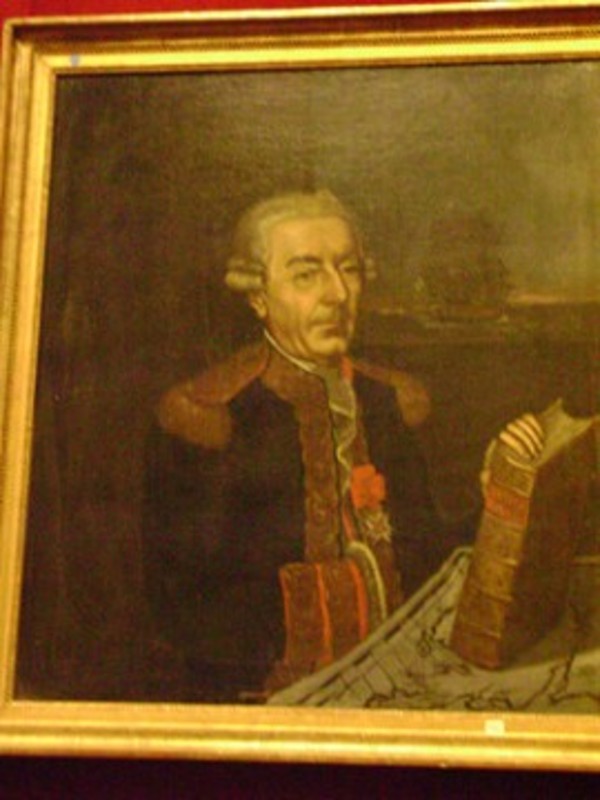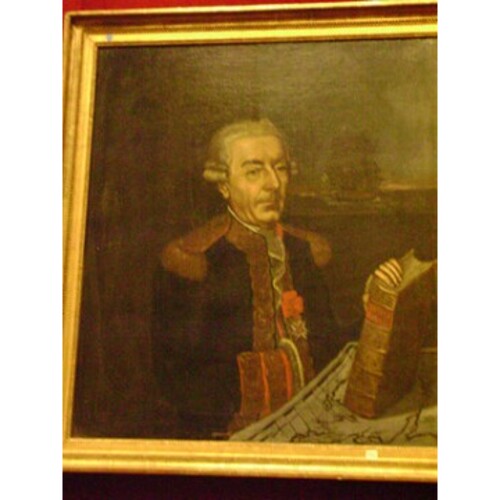
Source: Link
PELLEGRIN (Pelegrin), GABRIEL, mariner and naval officer; b. 16 July 1713 in the parish of Saint-Louis at Toulon, France, son of François Pellegrin and Marie-Anne Bonnegrâce; d. 19 June 1788 at Brest, France.
Gabriel Pellegrin came to Canada in 1734 as a pilot in the French navy. On being released shortly after from duties usual to such employment he assisted the port captain of Quebec, Richard Testu* de La Richardière, in carrying out the most extensive hydrographic surveys of the French régime. In 1735 they charted the Strait of Belle Isle, at that time known chiefly to fishermen; from 1738 to 1740 they surveyed the south coast of Newfoundland, the Gulf of St Lawrence, and the shores of present-day Prince Edward Island, New Brunswick, and Nova Scotia from Baie des Chaleurs to the Strait of Canso.
On 18 Nov. 1738 Pellegrin married Madeleine Boissy at Quebec and two children were born during the next five years. Pellegrin appears to have left the colony during the War of the Austrian Succession when he may have seen active service in the navy, With the coming of peace the French attempted to improve navigation in the St Lawrence. Quebec had been without a port captain, the responsible official, for several years, but Philippe-Marie D’Ailleboust de Cerry took up the post in 1749 and in 1751 Pellegrin joined his staff as harbour-master. Pellegrin’s chief task was to pilot naval vessels from Bic upstream to Quebec, but his broad knowledge of the St Lawrence soon led to more important duties. In 1752 he was promoted port lieutenant and the next year his annual stipend was increased by 200 livres.
Pellegrin caught the particular attention of the authorities in 1755 when he piloted a large squadron to France by way of the Strait of Belle Isle since the British were thought to be waiting on the usual route south of Newfoundland [see Emmanuel-Auguste de Cahideuc*, Comte Dubois de La Motte; Edward Boscawen*]. His success was rewarded with a bounty of 4,000 livres, an annual gratuity of 600 livres, and a promotion to deputy port captain of Quebec. While in France he constructed two charts of the full length of the St Lawrence and submitted a long critique of recently published French charts of the river. When in the spring of 1756 he travelled to Canada on the Licorne with Montcalm*, the new commander formed a favourable impression of him. Pellegrin’s services were not in great demand, however, and in the fall he was given command of the Abénaquise and sent to France with dispatches. He again sailed through the northern exit from the St Lawrence and after safely reaching France was given the modest but substantive rank of fire-ship captain in the navy, a promotion which aroused the jealousy of the port captain, Cerry, who held no naval rank. In September 1757 Pellegrin returned to Quebec and was appointed royal hydrographer to replace Father Joseph-Pierre de Bonnécamps. Pellegrim complained to Intendant Bigot that there were few people studying navigation and pilotage, but more urgent matters were pressing on the colony and the post became a sinecure.
Soon after his return to Canada Pellegrin renewed his acquaintance with Montcalm and in October 1757, accompanied by the senior artillery officer, Montbeillard [Potot], and Bougainville*, inspected the north shore from Quebec to Cap Tourmente. At the latter place the party discovered an emplacement for a defensive battery, safe from assault and so close to the navigation channel that enemy ships could be brought under fire for almost a quarter of an hour. During the winter Pellegrin continued to develop ideas for the defence of the St Lawrence distinguished by their practicality. He was probably the source of the recommendations made by Bougainville to the minister of Marine in the winter of 1758–59, which emphasized that the colony’s defences should begin at Gaspé and Sept-Îles. No enemy, Bougainville wrote, could get past ten well-placed warships stationed in the St Lawrence. Several of these ships, if in danger of sinking after engaging the enemy, should be run aground to serve as batteries at locations indicated by Pellegrin. Authorities in the colony should be ordered to consult Pellegrin and René-Nicolas Levasseur, the master shipbuilder, on everything relating to the riverine defences. Meanwhile Montcalm forwarded to Vaudreuil [Rigaud] with his own endorsement a similar report signed by Pellegrin. Although in February 1759 the minister of Marine instructed the governor and intendant to employ Pellegrin, the latter’s advice continued to be ignored. Whether this failure to act on his recommendations was due to neglect or to the influence of other interests, the responsibility must be laid on Governor Vaudreuil.
In May 1759, when it was learned that British ships were in the river, a proposal was made at a council of war to sink ten of the largest ships in the colony in the Traverse, the difficult passage southeast of the Île d’ Orléans. Pellegrin, who was taking up marker buoys in the Traverse and substituting false aids to navigation, was not even called to the meeting; on his return he reported that it was impossible to block the passage. Six days later, on 1 June, all but a few provision ships and frigates were sent to find protection at Batiscan, 50 miles above Quebec. Soon after Pellegrin sounded the waters off the Beauport beaches to determine how close enemy warships could sail to shell the shore, but his subsequent offers of service were rejected. He took no part in the fire-ship attacks in July [see François-Louis Poulin* de Courval], which failed as Pellegrin had anticipated. On 15 September he was one of those who signed the articles of capitulation.
Pellegrin returned to France and resumed his naval career. In 1770 he was made a knight of the order of Saint-Louis for his long and devoted service. After several years in the East he was stationed at Brest in 1773 and remained there until his retirement. At that time he was promoted lieutenant-commander.
Gabriel Pellegrin probably had more accurate knowledge of the St Lawrence River than anyone in New France, but he was apparently the victim of his own zeal and probity, the jealousy of his immediate superior, and perhaps also of the vested maritime interests of other influential persons. Late in June 1759 the anonymous author of the “Journal du siège de Québec” noted: “hundreds of times he has offered his services and his understanding. It appears that they absolutely do not want either. He is a perfectly upright man. If I dared, I would say that it is this quality which prevents him from having any employment.” Pellegrin’s Canadian career casts a small but significant sidelight on the complex internecine struggles in the last years of New France.
AN, Col., B, 67, f.111v; 97; 103, f.13; 109, f.66; C11A, 68, ff.90–93; 69, ff.20–21; 94, f.40; 95, f.80; 101, f.182; 103, f.234; E, 67 (dossier Cerry); Marine, B4, 68, f.215; C7, 240 (dossier Pellegrin); 3JJ, 273; 4JJ, 8, no.46; 6JJ, 65, no.17; 126. Bougainville, “Journal” (A.-E. Gosselin), ANQ Rapport, 1923–24, 311. Coll. des manuscrits de Lévis (Casgrain), IV, 91–94; VI, 24, 37, 39, 41, 307, 523–26, 535. “Journal du siège de Québec” (Æ. Fauteux), ANQ Rapport, 1920–21, 141, 160, 208. Knox, Hist. journal (Doughty), III, 174–78. “La mission de M. de Bougainville en France en 1758–1759,” ANQ Rapport, 1923–24, 21–23, 27–29, 61. NYCD (O’Callaghan and Fernow), X, 961–62. P.-G. Roy, Inv. ord. int., II, 243–44, 291–92; III, 174, 206. Tanguay, Dictionnaire.
Cite This Article
James S. Pritchard, “PELLEGRIN (Pelegrin), GABRIEL,” in Dictionary of Canadian Biography, vol. 4, University of Toronto/Université Laval, 2003–, accessed April 25, 2025, https://www.biographi.ca/en/bio/pellegrin_gabriel_4E.html.
The citation above shows the format for footnotes and endnotes according to the Chicago manual of style (16th edition). Information to be used in other citation formats:
| Permalink: | https://www.biographi.ca/en/bio/pellegrin_gabriel_4E.html |
| Author of Article: | James S. Pritchard |
| Title of Article: | PELLEGRIN (Pelegrin), GABRIEL |
| Publication Name: | Dictionary of Canadian Biography, vol. 4 |
| Publisher: | University of Toronto/Université Laval |
| Year of revision: | 1979 |
| Access Date: | April 25, 2025 |



